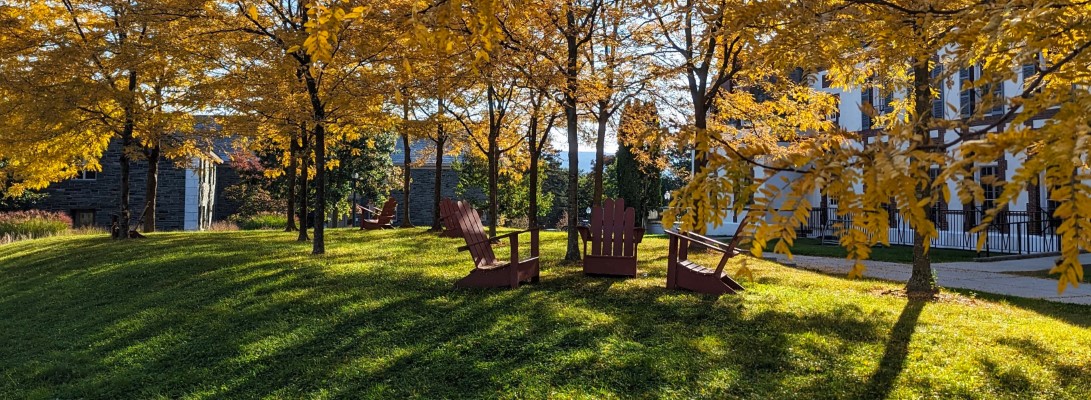Our Vermont campus is a managed landscape consisting of few species – primarily open lawn and mature canopy trees. Like much of the United States, lawns and turf have dominated the maintained Middlebury College landscape for decades. This traditional archetype is leftover from archaic and colonial institutional landscape ideals, and it fails to act in stewardship to the landscape and animals who share this land, to create spaces for community engagement with the natural world, and to reflect the college’s climate commitments as outlined in Energy 2028.
One of the greatest things about Middlebury is this global commitment, and our landscape should reflect that’s as well. We recognize now that modern landscapes, and in particular college campuses, are more complex, featuring a variety of ecosystems and environments. Where do we fit in the ecology of the earth? Our landscape is something that Middlebury can uniquely lead both in Vermont and globally, transforming the way institutions view their managed landscapes in the local ecosystems.
Rewild Middlebury is the name and the concept, but the actual work is ‘Restore Middlebury’. It’s the landscape management for sustainability, the restoration of landscape to more sustainable, more inclusive, while still respecting historical landscape ideals of a college campus. Our goal is Carbon sequestration, and this dictates much of our management decisions. It’s landscape management, not landscape maintenance, because nature doesn’t ‘maintain’, she grows, adapts, changes not only seasonally but generationally. We hope to share the beauty of Vermont through our landscaping practices for all community members to share in, engage with, and learn from.
The genesis for this project was the realization that, with a couple of exceptions, we treat every square foot of lawn surface the same at Middlebury, regardless of use or appropriateness. We mow 97 acres, for approximately 1920 hours in a year, figured at 80 hours/week for 24 weeks of mowing. This does not include maintenance of equipment, string trimming, or push mowing. This also does not include anything related to Athletic field maintenance or surrounding lawns. This costs the College ~$12,000/year in fuel, 20 tons of carbon emissions annually, and 72 ½ tons of hydrocarbon and nitrous oxide emissions (pollution). Our lawns also take away from species diversity on campus, including pollinators, invertebrates, fungi, and birds. Most importantly, lawns across the U.S. are an old unsustainable practice, and many forward-thinking institutions are changing management practices to more modern and sustainable methods.
Two students in the Sustainable Solutions Lab worked in 2022 on a lawn reduction proposal and have related it to the institution’s Energy 2028 goals. (For their complete report, see here.) They’ve modeled a 28% reduction in lawns mowed, meeting the Energy 2028 goals of reducing energy consumption on campus by 25%. The proposal calls for 7 ‘cover types’ in the landscape-think of this as 7 different management plans for areas on campus presently in mown lawn.

- High Performance Lawn- areas like the commencement quad, Battell Beach, and the various volleyball courts set up for LS. Managed more intensively than at present, treated nearly like sports fields.
- Park Lawn- areas such as below the Chapel, Library Quad. A gradual reduction in maintenance, mowing on a more prescriptive basis rather than our weekly cycle. Areas under trees do not require the mowing frequency as exposed lawns.
- Rough Lawn-these areas would be mowed until commencement, then only mown monthly at best, or less in outlying locations.
- Native Fescue Areas-new techniques in turf maintenance make these areas more appealing and sustainable than our last ‘no-mow zones’. Existing lawn is treated to remove weeds and non-native grassed, and native fescue grows to full height and mowed at the end of the year. Ralph Myhre Golf Course has switched to this in their rough areas and has been widely praised.
- Clover Lawns-another new technology worth trying-a dwarf clover growing no more than 2” tall, useful in low foot traffic areas where a low lawn look is needed in the landscape.
- Clayplain Forest plantings-most intensive and costly to start, but the most sustainable and low input long term. Land in Vermont wants to be forested, all inputs into the landscape attempt to avoid this.
- Pollinator Plantings-a mix of wildflowers and intensively managed beds to increase diversity on campus.
This process began with the implementation of a 2 year pilot plan in the Library quad and surrounding areas, trialing all landcover types. Two large sections of lawn were converted into Native Fescue areas, and two smaller sections south of the Main Library were planted in Microclover. One section of lawn north of Axinn was replanted into native wildflower habitat, and finally one section around an existing storm water treatment swale is now Clayplain Forest trees.

More Information-
- Goals-our hopes and rationale behind Rewilding
- Baseline-maps and future plans
- Cover Types-the new species and management plans
Questions or feedback can be directed to Tim Parsons, and for more information please visit go.middlebury.edu/rewild .

You must be logged in to post a comment.